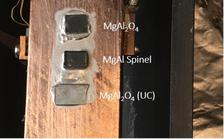The photo shows three different samples on the sample holder. (Credit: DESY)
Magnesium aluminate spinel (MgAl2O4) has received significant practical interest because of the predicted tolerance to ionising irradiation. Therefore, this material is currently on the priority list of the EUROFUSION consortium for optical diagnostic windows in future deuterium-tritium fusion reactors. Investigations of radiative transitions in this material at the PETRA III beamline P66 and MAX IV beamline ‘FinEstBeAMS’ among others will help to further develop novel optical materials for use in these extreme environments. An international research team of scientists from the National Centre for Scientific Research (CNRS, France), University Sorbonne Paris Nord (France) and Institute of Physics of Tartu University (Estonia), taking part of the WPMAT - FM (Functional Materials) network, in collaboration with DESY and Faculty of Science of Yamagata University (Japan) have published their results in Journal of Luminescence.
Magnesium aluminate spinel (MgAl2O4) is a well-known material, which electronic band and defect structures are not yet well understood, especially in connection with so-called antisite defects. These special defects occur in ordered materials when atoms exchange their positions (here MgAl and AlMg). Their concentration is inherently very high and always exceed 10 % (>1.5×1021 cm-3) in the synthetic solids. Its formula can be detailed as (Mg1-iAl2I)T(MgIAl2-2i)OO4, where ()T and ()O signify respectively tetrahedral and octahedral sites in lattices, and i is the inversion parameter ranging from 0 for the normal spinel (Mg)T(Al2)OO4 to 1 for the inverse spinel (Al)T(MgAl)OO4. Furthermore, the antisites are effectively generated in extreme conditions of a strong irradiation with high-energy particles (n0, p+, He+, etc.) which may result in amorphisation and mechanical damage of a material. At the same time, MgAl2O4 is of special interest due to its expected tolerance to ionising radiation. This effect is related to an effective interstitial-vacancy recombination process, since the formation of antisites requires the lowest energy among all known lattice defects.
The research team has provided a first assignment of the intense far-ultraviolet (hν≈5 eV) photoluminescence in MgAl2O4 spinel materials to the donor-acceptor pair (DAP) electronic transitions involving MgAl and AlMg antisites as well as oxygen vacancies VO. They have shown that an intense ionising irradiation with He+ ions (energy 150 keV, fluence 1017 particles/cm2) creates lattice defects with energy levels close to the conduction band which deactivate closely spaced DAPs while unaffected distant DAPs. The intraband defect structure of the spinel is conserved after irradiation which indicates that the material is self-healing and can withstand even intense ionising radiation. For the measurements, the MgAl2O4 crystal was cooled down to a temperature of ~10 K in a chamber vacuum. After excitation with synchrotron radiation in the UV-visible spectral range, photoluminescence (PL) and PL excitation (PLE) spectra were measured.
The obtained results will provide better understanding and control of the electronic structure of this material. It permits further analysis of the transparent nanophase functional spinel ceramics where electronic transitions are affected by grains bulk and boundaries. Based on these results, the degree of inversion in MgAl2O4 materials might be better controlled in a broader range even beyond i = 0.4, accessible via XRD measurements.
Reference:
L. Museur, E. Feldbach, A. Kotlov, M. Kitaura, A. Kanaev, Donor-acceptor pair transitions in MgAl2O4 spinel, J. Lumin. (2024) DOI: 10.1016/j.jlumin.2023.120235







